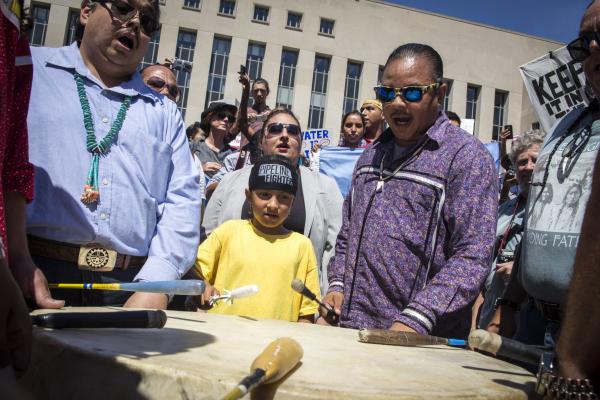On Aug. 24, more than 300 people gathered outside the U.S. District Courthouse in solidarity with the Standing Rock Sioux Tribe to protest the Dakota Access Pipeline (DAPL), a crude oil pipeline threatening their way of life. Inside the courthouse, the District Court heard initial arguments on the Standing Rock lawsuit against the U.S. Army Corps of Engineers.
Tribal members spoke, sang, and prayed alongside allies, making their voices resound through the halls of Capitol Hill.
Though construction on the controversial Keystone XL pipeline has definitively halted, the age of massive, billion dollar pipelines is not over. In May 2016, construction began on the DAPL, which will pump 470,000 barrels of Bakken Shale oil from the Bakken Shale Formation of North Dakota to markets in Illinois. These plans were stopped on Aug. 12, when members of the Standing Rock Sioux tribe, objecting to the decimation of their sacred lands and water, blocked construction.
Of particular concern to protesters is the potential for water contamination, as the pipeline is set to cross the Missouri River less than one mile from the Sioux Standing Rock Reservation. Since the initial arrest of Standing Rock Chairman Dave Archambault, nearly two thousand others have allied with the tribe, camping near the construction site in Cannon Ball, N.D., to postpone construction on the project.
If this pipeline is anything like every other crude oil pipeline, the likelihood of a leak or break in the line is significant. Last year, 40,000 gallons of crude oil spilled into the Yellowstone River after a pipe ruptured upstream. This was only one of thirty-nine oil pipeline leakages in 2015.
The construction of the pipeline represents just another chapter in the centuries-long attack on the sovereignty, rights, and spirituality of Native Americans. At the protest, Mark Charles, a historian, activist, and columnist for Native News Online, connected the pipeline to “the implicit bias of the United States – which is that Native Americans are less than humans.”
Similarly, Bill McKibben, author and founder of 350.org, argued that if the District Court suspends work on the pipeline, “it would mean that after 525 years, someone had actually paid attention to the good sense that Native Americans have been offering almost from the start.”
Unlike the Keystone pipeline protests, which garnered headlines around the world, the Standing Rock protests have largely gone ignored – silenced, in McKibben’s words, as a result of “the endless history of unfairness” experienced by Native Americans.
The pipeline, which crosses the Missouri River, also threatens the spiritual health of sites considered sacred by the Standing Rock Sioux Tribe.
“This issue is not just an Indian issue. It’s a human issue. One of the things you need to live is water – water is life,” said Harold Frasier, Chairman of the Cheyenne River Sioux Tribe on Aug. 24.
Anna Lee, a member of the Standing Rock Youth, agreed.
“In Dakota/Lakota we say ‘mni Wiconi.’ Water is life. Native American people know that water is the first medicine not just for us, but for all human beings living on this earth,” she wrote on the petition website.
The spiritual call to protect the earth is not unique to Native Americans. It’s inherent in Christianity as well. This pipeline risks the degradation of lands we’re called to protect and the marginalization of a people long oppressed. For Christians, as well as Dakota people, mni Wiconi (water is life):
“But whoever drinks the water I give them will never thirst. Indeed, the water I give them will become in them a spring of water welling up to eternal life." (John 4:14)
Until the District Court halts the construction of the pipeline, the question lingers: What happens when the water of life is poisoned?
Got something to say about what you're reading? We value your feedback!


